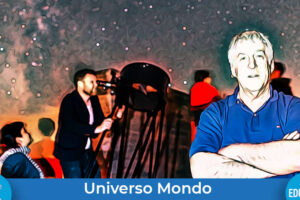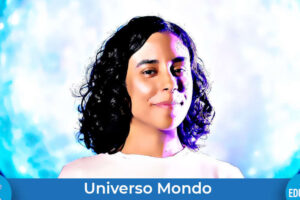Aggiornato il 28 Novembre 2024
A belated happy new year to all readers of Universe World. We start 2024 with a journey to Nigeria, where we meet Olayinka Fagbemiro, chief scientific officer leading the STEAM education initiatives at the national space agency, while also guiding a large team of volunteers to disseminate astronomy throughout the country with Astronomers Without Borders Nigeria, an NGO which she herself founded and coordinates at national level.

Welcome to our column. As customary, tell us something about yourself: what is your current job and what led you there?
I have a 17-year experience working at the Nigerian space agency, where I currently head the Science, Technology, Engineering and Mathematics (STEM) Outreach Unit.
I started out obtaining a Bachelor’s degree in Computer Science in 2004, then proceeded to have a Master’s degree in Technology Management and currently rounding off a PhD in Geoinformatics.
I have always had an interest in STEM, even as a child, and even though I didn’t get the opportunity of knowing about space science early enough, I loved geography so much and I imagine that fuelled my interest in the space sciences when I eventually had the opportunity to make that decision.
Can you tell our readers a bit about the context of astronomy and space science in Nigeria?
Astronomy and space science are not really very popular in Nigeria. In fact, at the elementary and high school levels, there is no existing curriculum for both. It therefore means every contact pupils have with both subjects, are through extra curricular means, or snippets from other STEM subjects, such as geography, physics, etc.
Even at the tertiary level, Nigeria has less than 10 universities that offer astronomy and space science programs, in a country of over 200 million people. It means there is an urgent need to create more awareness across the different levels.

What about the National Space Research and Development Agency (NASRDA)? Tell us about its main activities…
The National Space Research and Development Agency (NASRDA) was established in 1999. Some of the functions of the agency as provided for in the Act establishing it include the development of satellite technology for various applications and the operation of indigenous space system for providing space services; it shall be the government agency charged with the responsibility for building and launching satellites, and the repository of all satellite data over Nigeria’s territory; accordingly, all collaborations and consultations in space data related matters in Nigeria shall be carried out or undertaken by or with the agency.
You are based at the headquarters in the capital, Abuja, but are there also other premises in the country?
The Agency has a number of operational centres across Nigeria including the Centre for Atmospheric Research (CAR) in Anyigba, the Centre for Geodesy & Geodynamics (CGG) in Toro, the Centre for Basic Space Science (CBSS) in Nsukka, the Centre for Satellite Technology Development (CSTD) in Abuja, the National Centre for Remote Sensing (NCRS) in Jos, the Centre for Space Transportation & Propulsion (CSTP) in Epe and the Centre for Space Science & Technology Education (SSTE) in Ile-Ife. Also, in an effort to domesticate space science and technology in Nigeria, several laboratories were established across the country.

Let’s talk about your work as NASRDA’s chief scientific officer: how do you implement the agency’s STEAM (Science, Technology, Engineering, Arts and Mathematics) education initiative?
My STEAM education initiatives at the space agency basically revolve around the need to create awareness about space science and engineering, getting young people to develop interest in STEAM. Through our “˜catch them young’ initiative, we are getting elementary and high school kids involved in the space agency’s STEAM programs.
We organise excursions to the agency for schools across Nigeria, we also invite STEM teachers to participate in various teachers training programs. Some of our projects include the “˜Space Ambassadors’ program, where we invite pupils to participate in space project exhibitions and the kids with the best projects get to be the Space Ambassadors for a period of time, usually one year.
We also organise space quizzes and debate programs for elementary and high school kids, where they get to showcase their knowledge of space and stand a chance to wins exciting prizes for themselves and their schools.
That is such an extensive and fascinating program. On top of that, you also have an important role in another organisation: can you tell us more about it?
I am a STEM advocate and founded a STEM NGO, Astronomers Without Borders (AWB) Nigeria, as part of my contributions to bridging the gaps in STEM education, and most especially the gender gap, and addressing inequality in STEM education in Nigeria, with a special focus on Northern Nigeria.
AWB Nigeria organises astronomical based events on a regular basis to capture the popular imagination, create excitement and generate media attention. These events represent an unprecedented opportunity for STEM awareness and support for STEM education. Our organisation uses astronomy as a tool to inspire children and as a starting point for continuing STEM education in their schools.

What are the main goals of AWB Nigeria?
Our activities aim to address different social and educational challenges in Nigeria, for example gender lopsidedness issues in school enrolment and STEM encouragement for children. We also develop extra curricular activities such as teacher trainings, setting up astronomy clubs in schools and other science-based outreach. We have also been involved with bringing STEM education through astronomy to the less privileged in society through our program with children at the Internally Displaced People’s (IDP) camps across Nigeria.
AWB Nigeria brings the world together to share our passion of astronomy and the wonders of the Universe. Our ‘observing the skies’ projects bring people together to share their activities with each other and can be a tool for education, equality, peace and culture.
Tell us more about the project with the Internally Displaced people’s camps…
This is one of the biggest projects we have worked on. Because of ethno-religious conflicts and terrorism, Nigeria has over 2 million internally displaced persons, 80% of which are women and children according to the International Organization for Migration (IOM). Of these, 42% live in camps and camp-like settings, while 58% live in host communities.
One common result is that displacement affects the education and mental health of children. In a lot of cases, children drop out of school. This has resulted in an increase of the number of out-of-school children in Nigeria to 13.2 million children.
This problem breeds grounds for inequality, illiteracy, peace and security problems, as well asdevelopmental challenges for the future of the IDP children. As displaced children, they face an uncertain future, where it may be difficult to compete with their mates in other stable regions in terms of education. Some of the children deal with psychological trauma and hopelessness as a result of their experiences during the conflicts.

How do you bring astronomy to these communities?
The project combines setting up solar powered learning hubs in the camps, as well as conducting Cognitive Behavioural Therapy assessment on the IDP children to determine the state of their mental health. We partnered with other organisations to ensure that those that need further help get the desired attention and care.
The main objective is to use astronomy as a tool to counsel, heal and inspire traumatised children that have been displaced due to conflicts in Nigeria.
The IDP are located in remote locations, mostly without electricity, therefore a team of engineers set up a solar-powered learning hub in a refurbished 40-feet shipping container.
The hub is for the children to have access to learning materials, and for the project team to engage the children remotely. Other project team members serve as science communicators who are passionate about making tangible impacts using science.
This project is ongoing, with the aim to reach out to many more of the over 10 million kids who presently live in IDP camps across Nigeria.
Congratulations on this very inspiring project. On the basis of your experience, what would you say are the major challenges for a science communicator and educator today, in Nigeria?
I think the major challenge a science communicator and educator faces in Nigeria would be that of inadequate funding. STEM programs in Nigeria are grossly underfunded. This has given rise to other challenges such as science educators having to teach in dilapidated classrooms, poor ad sometimes, non existent training and retraining programs, lack of adequate laboratories, shortage of instructional materials, poor motivation and renumeration, unproductive working environment and inadequate infrastructural facilities, poor curriculum development, lack of adequate supervision. The list is endless.

You also serve as the International Astronomical Union (IAU) National Astronomy Education Coordinator (NAEC) for Nigeria. How do you collaborate with international partners within the IAU, and what do you bring home from this experience?
My experience with the IAU Office of Astronomy for Education (OAE) has been very impactful on my work back home: I had access to various educational resources to make the teaching of astronomy fun, and met a wonderful network of international astronomy educators who provide a great platform for various collaborations.
Our IDP projects were funded by the IAU Office of Astronomy for Development (OAD) and we have also in the past made use of certain resources from the IAU Office of Astronomy for Outreach (OAO). We have great relationships with a good number of partners within the IAU.
Also based on your international experience, what would you say are the major challenges for a science communicator and educator today globally, and are they different from the challenges you experience locally, in Nigeria?
Well, for the most part, I think a lack of interest in science by younger people is a major challenge for science communicators globally. I also believe the problem of underfunding is a global one. These challenges are not any different from what we experience in Nigeria, however, I would think science communicators in the developed world have it a lot better than those from developing and under-developed countries.

What are the most exciting and most difficult parts in your job?
The most exciting part of my job is knowing you’re doing something which impacts a whole lot of impressionable, young minds, and realising this positive impact is going to outlive you! Realising you are able to influence young people, helping to shape their future and seeing them embrace STEM is very satisfying. Being a role model, and having young people, especially females, look up to you and wanting to follow in your footsteps, is everything!
The most difficult part of my job would be having so many great ideas on how to go about making impacts, seeing needs that I’m not able to meet, just because there is a dire shortage of resources! This can be really frustrating.
And now the final question, which has also become a classic: are there any authors, books, people or special events that influenced you along your journey?
A whole lot of people, whether directly through personal encounters with them, or through reading their books, articles, interviews, presentations, and so on have influenced me along my journey. My father was my very first influence in STEM, being a STEM professional himself. He introduced me to STEM at a very early age, and he nurtured my interest until I was old enough to take the decision to pursue a career in STEM.
Along the line, I have had the privilege of meeting people who inspired me in space sciences and Astronomy, people like Prof Jegede, Mrs Ngozi Okonjo Iweala, Mike Simmons, the former President of Astronomers Without Borders (AWB), Charles Bolden, former NASA Director, Tim Spuck, Dr Sian Proctor, Jean Pierre Grootaerd, Dirk Frimout, Declan Kirrane, Kevin and Carolina Govender, among many others. I have been very privileged to have had direct, and personal encounters with these people, encounters that have really shaped my career up till date.




I’m so much glad,
How can my son joined the club, because he want to become an astronaut